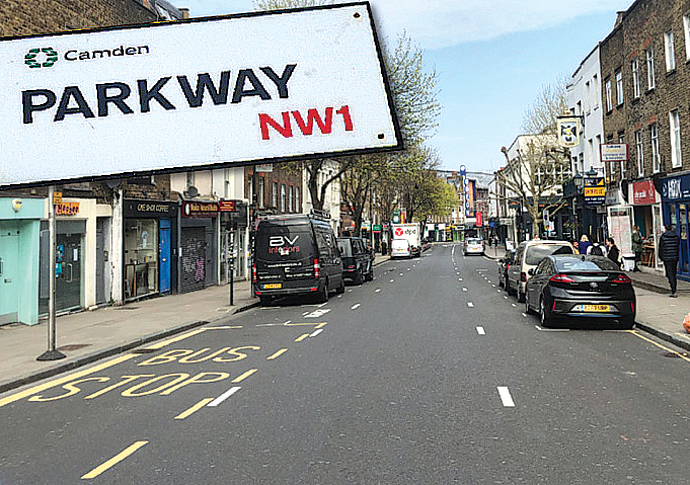40 years ago, one writer set out to write a comprehensive history of Camden Town
Some passages in David Thomson’s eccentric account of life in Camden Town make uncomfortable reading, writes Pavan Amara
Thursday, 30th March 2023 — By Pavan Amara

FORTY years ago, the journalist David Thomson set himself a goal.
He would write a comprehensive history of Camden Town. He didn’t achieve it. Instead, he spent his days in the pub, downing pints with fellow alcoholics, the homeless, punks, navvies, retired police officers and anyone else who stumbled through the door.
He roamed the streets, stopping to chat – often drunk – with the eclectic cast of characters that shaped 1980s Camden Town.
Meanwhile, the historical manuscript he was meant to be crafting gathered dust. He had writers’ block, he said, and the task was overwhelming.
To break the deadlock, Thomson started a diary, intending to write short entries detailing his everyday life. What came from that, was not the planned history book. But perhaps something more valuable, a social history.
This year is the 40th anniversary of In Camden Town, by David Thomson, which was published by Hutchinson in 1983 to glowing reviews from the Guardian and Times Literary Supplement.
It was the printed version of the diary he kept: a bad-tempered account of the struggles and hopes of Thomson and those he befriended, mixed in with eccentric musings on the area.
It was his 10th book. Thomson had previously written a mix of fiction, memoir, and children’s books.
The opening section describes the 66-year-old writer sitting outside the Spread Eagle pub in Albert Street, and drinking in the sunshine. Here, he spotted the writer Beryl Bainbridge – now deceased – who was nominated five times for the Booker Prize.
“…[Beryl] was intensely interested in everything around her and in what people say,” he wrote. “I had nothing to say except offer her a drink. She wouldn’t have one but sat down beside me on one of those spindly white chairs.”
He recounts the conversation between himself and Bainbridge, who confides that her 15-year-old daughter drank a cup of vodka, then fell off a bus, fractured her skull, came home in one piece after a hospital visit, and then “dyed her hair green, and [she was] off again”.
The world Thomson depicts, is both recognisable and gone. Camden Lock in 1980 was a scene similar to the present day: “Canal black, with plastic cups floating on it, potato-crisp bags, Kentucky chicken and, I think, a dead cat.”
But Parkway had been newly named, from Park Road, and the Dublin Castle and Spread Eagle pubs had recently got tables.
“There were no tables in the old days, and now the few there are not enough,” he writes.
Early in the book, Thomson walks past the Post Office in Camden High Street.
Here, we meet “Tipsy Davy” or Davy Sloan, distinctive with his “very thin face” and a stream of alcohol-related health problems. Characters like this, and his on-off alcoholic girlfriend Mary, pepper the pages.
“Both her legs have ulcers that won’t heal, both bandaged and seen to once a week at Kentish Town Health Centre,” Thomson writes. “Her hand has a festering cut from a rusty nail on a boarded-up house she was trying to break into to kip. I asked about Davy and she shook her head.”
But the book is a product of its time: it was published only a few decades after Commonwealth immigration to the UK began in any significant way. It reflects its era. Thomson’s attitudes to race do not age well. Yet his sentences are a printed testament to the discrimination ethnic minority Britons faced.
Despite a long marriage and three children, a house in Regents Park Terrace, and a former career as a BBC journalist, the book’s second half plunges its reader into Thomson’s desperate life.
He has a drinking problem, rarely goes home, has multiple hearing issues, and loses an alcoholic friend to pneumonia.
At times, it is an uncomfortable read: the writer describes sitting behind young women on the bus and placing his hands on the metal bar at the back of their seats, in the hope of touching their hair.
He was born in 1914, but little is known about the circumstances of his death.
He wrote three books after In Camden Town, with the final one published in 1987. Yet only four of his works – not including In Camden Town – are available to order.
On GoodReads, the world’s largest website for reader reviews and book recommendations, contemporary readers have bought old copies of In Camden Town. Their reviews refer to it as “a little gem” and a “touching insight into a world largely condemned to the past”.
There is still high demand for Thomson’s work.
“I ordered in a copy of his earlier memoir Woodbrook a few days ago for a customer,” says Gary McLaren of the Owl Bookshop in Kentish Town Road, which opened in 1974.
“It is interesting that this title has stayed in print.
“We did well with In Camden Town when it was in print and often get requests for it now. It would be fantastic if it was available again.”
